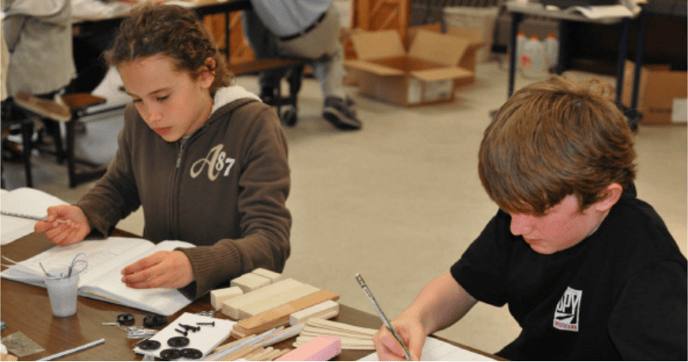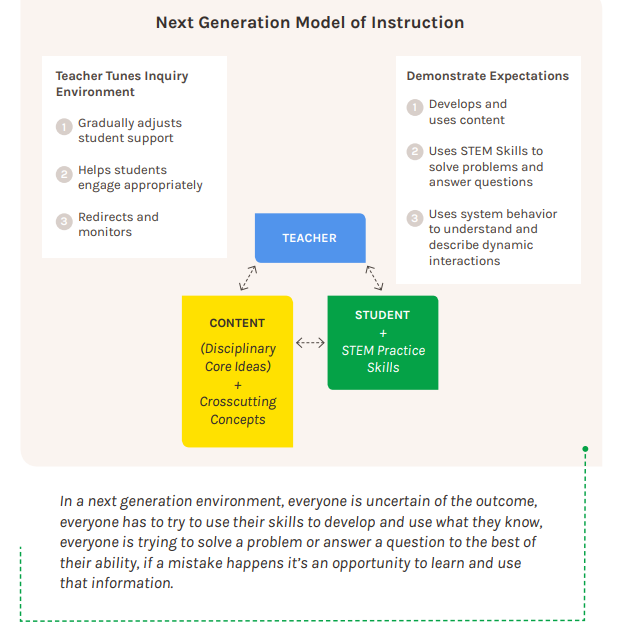
In order to develop a growth mindset in science classrooms and achieve the vision of NGSS, it will be important to transition from a traditional model of science instruction toward a next generation model of instruction.
In a traditional model, content flows through the instructor, who models and demonstrates and explains scientific ideas to students. Students, for their part, recall facts, repeat demonstrations they have seen, and summarize phenomena. Students are not actually experimenting or designing on their own. They also aren’t learning to take risks, cope with mistakes, and learn from their mistakes. They are therefore not being scientists and engineers.
Instead, developing a growth mindset and achieving the vision of NGSS will require a next generation model of instruction. In this full inquiry next generation model, the teacher plays the role of coach as students engage in the three dimensions—the skills (science and engineering practices) dimension, the content (disciplinary core ideas) dimension, and the systems thinking (crosscutting concepts) dimension.
Students develop and use the science and engineering practices that will enable them to develop and use the content, or disciplinary core ideas. They will connect these ideas through crosscutting concepts.

That is really the value for learning: the outcomes aren’t known by either the teacher or the students. That's how science and engineering skills are developed, by interacting with material in an open inquiry environment without a pre-determined outcome.
And that's how the level of rigor and challenge can be adjusted in the real time from one week to the next.
Through development and use of these practices, students can plan investigations, analyze data, argue from evidence, ask questions and define problems, and more. This is not a role the teacher plays, but instead coaches students to do.
This is because a next generation inquiry environment should challenge a student's higher order thinking. When you challenge students to create, evaluate, and analyze, the students explore their own ideas, working authentically and engaging with the material.
The purpose of experimenting and prototyping in the classroom is for students to take something they thought about, create a plan, and then carry it out.
That's why planning is so important. It’s where students create something new to solve a problem or answer a question. They create an idea and then establish how they’ll test it. They evaluate and analyze the results of those tests to form judgments and claims, and to support those claims with evidence.
These are all examples of higher order thinking skills in action.
The Role of the Teacher
Teachers play a vital role in this next generation model. Their job is not to impart facts; a textbook can do that. They’re there to help students engage appropriately, redirect and monitor them, and adjust supports along the way.
For example, educators can create accountability through checkpoints to help encourage and nurture their students, maintain accountability, and teach a growth mindset.
As students go through these checkpoints, through trial and error, as they create a plan that doesn't turn out the way they expected, it doesn’t make sense to say, “You’re good at this.”
Instead, it makes sense to praise students’ effort and teach them to think about their thinking by helping students take what they've done and consider how it can be done differently. These checkpoints provide an opportunity to encourage students to analyze and evaluate their own work and their own outcome to create a new hypothesis or a new approach to the problem through a different prototype.
The teacher is still serving as a source of support, redirection, and monitoring, but students are allowed to work relatively freely, exploring their ideas and carrying out their plans. Student teams create those plans, then check in independently at established check-in points. At these points, teachers have the opportunity to ask questions, evaluate, differentiate, and redirect each team or the entire class as they see fit.
These checkpoints can be scaffolded depending on the grade level, but they’re important because they are one way that students learn what it means to be a scientist and engineer, and the level of work and collaboration that is expected of them.
This is a difficult process, but it’s worthwhile because in the younger grades, you’re working toward the blank notebook. Come fourth grade, students are planning their experiments in notebooks on their own, without the guidance of pre-written materials.
No Longer an “I Do, We Do, You Do” Mode
It’s important to note that the way a student thinks about mistakes is very much influenced by whether the teacher sets up the classroom to encourage a growth mindset. For example, part of the shift away from the traditional model of instruction means moving away from an “I do, we do, you do” mode because if I do it, and then we do it, what is there left for you to do?
The way the next generation inquiry environment needs to be structured is “you do, we do, I do.” Encouraging the “you do” model and praising effort rather than smartness is a good way to begin to develop a growth mindset in students.
With this new next generation model of instruction, students will be challenged beyond their present skills and knowledge. It is important that students be pushed to step into unknowns and take risks that they're not quite ready for.
Only when they are challenged do they have the best chance of going on to higher education and careers in which they think critically and perhaps become professional scientists or engineers, innovating and contributing to global scientific knowledge and engineering solutions.
This post was updated on Feb. 16, 2018.





